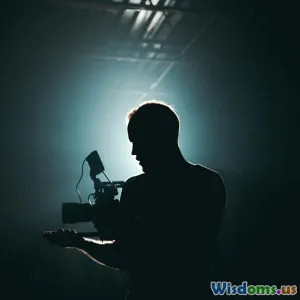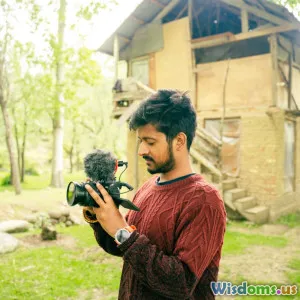
Documentary Photography: A Unique Perspective
7 min read Discover how documentary photography offers a powerful, authentic look at reality through compelling storytelling and impactful visuals. (0 Reviews)
Documentary Photography: A Unique Perspective
In a world saturated with images, documentary photography stands apart as a powerful medium that tells stories pure and unfiltered. Far from being mere snapshots, documentary images dive deep into the social, political, and cultural currents that shape human experience. This genre captures authentic moments—moments that inform, inspire, and sometimes shock us into awareness. But what truly defines documentary photography? And why does it matter so profoundly in today's media landscape?
The Essence of Documentary Photography
Documentary photography is grounded in the real world. It seeks to depict life as it unfolds, with honesty and clarity, providing a transparent window into events and environments. Unlike staged or heavily edited styles, documentary photographers prioritize truthfulness and often remain unobtrusive observers, capturing candid moments without interference.
Photojournalist Dorothea Lange, famous for her poignant images during the Great Depression, once said, “The camera is an instrument that teaches people how to see without a camera.” This highlights the core of documentary photography — it’s about revealing truths that might otherwise go unnoticed.
Historical Roots
Tracing back to the mid-19th century, documentary photography roots itself in early ethnographic and social photography. Photographers like Jacob Riis and Lewis Hine are considered pioneers; they used images to shed light on harsh living and working conditions in urban America. Their work influenced social reforms and fostered greater public empathy.
For example, Riis's book How the Other Half Lives (1890) included striking photographic evidence of poverty that stirred societal awareness and action. This historical precedent underscores how documentary photography has the power not only to document but to provoke change.
Core Elements of Documentary Photography
Authenticity and Ethics
Integrity is paramount. The most respected documentary photographers adhere to strict ethical guidelines to avoid manipulating images or contexts. Their commitment ensures that audiences receive an authentic glimpse into the subject's reality. This ethical stance often requires navigating complex dilemmas—respecting privacy while exposing truths, balancing storytelling against sensationalism.
Storytelling Through Images
Effective documentary photography isn’t just about isolated shots; it involves creating a narrative. A sequence of images might chronicle a journey, document a crisis, or explore a cultural tradition, all grounded in real-life events. This narrative dimension engages viewers, inviting them to connect emotionally and intellectually.
Technical Approach
Often, documentary photographers work in variable and uncontrolled environments, so mastery of composition, lighting, and timing is crucial. Many favor black-and-white imagery for its timeless, universal quality, while others use vivid color to emphasize reality's vibrancy or urgency.
Impact and Influence in Contemporary Media
Education and Awareness
Documentary photography educates by making complex issues visible. Climate change, refugee crises, and social injustices have gained global attention partly due to the compelling images circulated by documentary photographers. For instance, Sebastião Salgado’s Workers series captures the dignity and hardship of laborers worldwide, eliciting a profound human connection.
Activism and Change
Visual storytelling has driven social movements for decades. Contemporary organizations like Magnum Foundation foster projects that blend documentary photography with activism. The raw images from protests, disaster zones, and marginalized communities don’t just inform but mobilize public opinion and influence policy.
Challenges in the Digital Age
In an era overwhelmed with images from social media and smartphones, documentary photography faces the challenge of maintaining credibility. However, it remains distinguished by its depth of engagement and professionalism. Transparency about sourcing and context helps combat misinformation and builds trust with audiences.
Case Studies: Mastering the Documentary Perspective
Vivian Maier: Uncovered Genius
Though largely unrecognized in her lifetime, Vivian Maier’s street photography offers intimate and unstaged glimpses of urban life in mid-20th century America. Her rediscovered work exemplifies how documentary photography preserves everyday history with authenticity and nuance.
Steve McCurry’s "Afghan Girl"
The iconic portrait of Sharbat Gula is more than a striking image; it encapsulates the plight and resilience of refugees. McCurry’s photograph humanized a distant conflict, sparking global awareness and empathy.
Modern Impact: The Arab Spring
Amateur and professional documentary photographers documented protests across the Middle East, providing unfiltered perspectives that shaped international discourse. These images demonstrated how accessible technology democratizes documentary storytelling, expanding its reach and immediacy.
Conclusion: Why Documentary Photography Matters
In a world bombarded by images, documentary photography maintains its relevance through authenticity, storytelling, and social impact. It demands viewers pause and reflect, empathize and question, see the unseen.
Whether chronicling hardship or hope, conflict or culture, documentary photographers illuminate truths that might otherwise slip through history’s cracks. Their work not only enriches our understanding but can foster greater compassion and change.
For aspiring photographers or socially conscious individuals, immersing oneself in this craft offers the chance to be a witness, a storyteller, and a catalyst for awareness. Documentary photography is not just an art form but a vital lens through which we experience and engage with the complexities of our world.
Rate the Post
User Reviews
Popular Posts





















